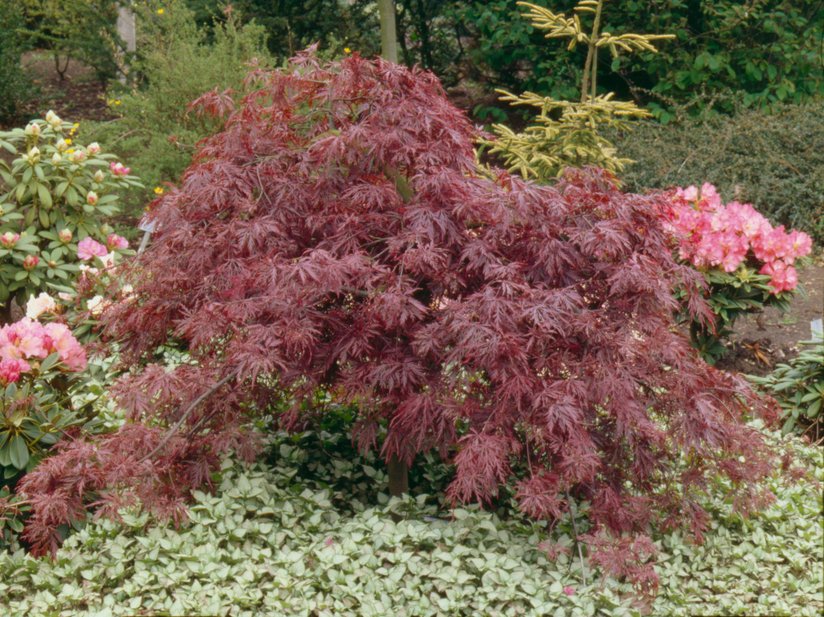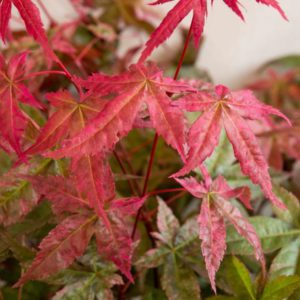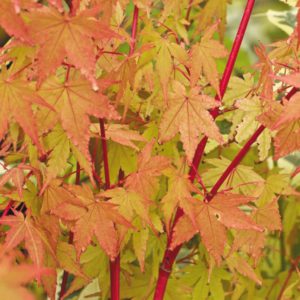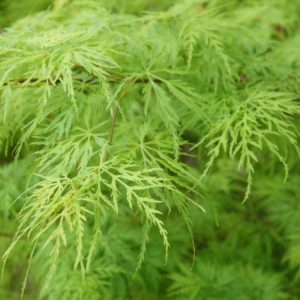Acer palmatum Inaba Shidare / Japanese Maple
Price range: €250.00 through €3,150.00
Frequently Bought Together


Description
Quick Facts
- Common Name: Weeping Japanese Maple, Inaba Shidare Japanese Maple
- Botanical Name: Acer palmatum ‘Inaba Shidare’
- Plant Type: Deciduous shrub/small tree
- Mature Height: 2-3m
- Mature Spread: 2.5-3.5m
- Flowering Period: April to May
- Flower Colour: Small purple-red flowers (insignificant)
- Foliage: Deeply dissected palmate leaves, deep purple-red throughout season, brilliant crimson in autumn
- Hardiness: RHS H5 (hardy in most areas)
- Soil Requirements: Moist, well-drained, slightly acidic to neutral
- Aspect: Partial shade to full sun (with shelter)
- Maintenance: Low
Description
Experience the dramatic elegance of Acer palmatum ‘Inaba Shidare’, the stunning Weeping Japanese Maple that brings exceptional year-round colour, graceful cascading form, and living sculpture to your garden with its deeply cut purple-red foliage and elegant weeping habit. This outstanding ornamental maple offers remarkable visual impact—deeply dissected, lace-like leaves in rich deep purple-red that hold their intense colour throughout the entire growing season without fading to green, a naturally graceful weeping habit with cascading branches that create elegant movement and sculptural presence, spectacular autumn transformation when the foliage intensifies to brilliant crimson and scarlet before falling, and compact size perfect for smaller gardens, containers, or as focal points, making this one of the most sought-after and visually striking Japanese maples for creating dramatic colour, architectural form, and oriental elegance in Irish gardens.
Throughout spring and summer, this captivating maple displays its characteristic deeply dissected palmate leaves with 7-9 narrow, pointed lobes that are cut almost to the base, creating an exquisite lace-like or feathery texture. The foliage emerges in spring in rich deep burgundy-purple and maintains this intense dark colouration throughout the entire season—one of the best purple-leaved maples for colour retention. The gracefully weeping branches cascade downwards, creating elegant layers and sculptural form that becomes increasingly dramatic with age. New growth appears in slightly brighter red tones, creating subtle colour variation and textural interest. In spring, small purple-red flowers appear but are largely hidden by the emerging foliage. In autumn, the foliage transforms into spectacular shades of brilliant crimson, scarlet, and orange-red, creating one of the finest autumn displays of any Japanese maple before the leaves fall to reveal the elegant branching structure for winter.
This remarkable cultivar is a Japanese maple of the Dissectum Atropurpureum Group, with ‘Inaba Shidare’ meaning ‘Inaba Waterfall’, perfectly describing the cascading waterfall-like habit. ‘Inaba’ refers to a region in Japan. Hardy and adaptable once established, this maple thrives in Irish conditions when given appropriate shelter from harsh winds and late spring frosts which can damage emerging foliage. The deep purple-red colour holds remarkably well throughout summer, unlike many purple-leaved maples that fade to bronze-green. Slower-growing and more compact than many Japanese maples, making this ideal for smaller gardens.
Create stunning compositions by planting as spectacular specimen features in prominent positions where the weeping form and intense foliage colour can be fully appreciated—particularly stunning beside water features where the cascading form is reflected. Magnificent in oriental-style gardens, contemporary landscapes, or woodland settings. Exceptional in large containers on patios and terraces where the sculptural form creates dramatic focal points. Works beautifully underplanted with low-growing shade-tolerant perennials like hostas, ferns, and Japanese forest grass (Hakonechloa), or surrounded by gravel for minimalist Japanese-inspired designs. Plant where protected from harsh winds and where the autumn colour can be backlit by low sun.
Caragh Garden Notebook
Planting: Space plants 3-4m apart if planting multiples, or allow 3.5-4m for specimen placement to accommodate the cascading spread. Plant container-grown specimens year-round, though spring or early autumn is ideal. Dig holes twice the width of the root ball and incorporate generous amounts of ericaceous compost or organic matter. Plant at the same depth as the container—avoid planting too deeply. Choose sheltered positions protected from harsh winds, cold easterly winds, and late spring frosts. Water thoroughly and mulch generously with organic matter or composted bark.
Soil Preparation: Thrives in moist, well-drained, slightly acidic to neutral soil with pH 5.5-7.0. Prefers fertile, humus-rich, moisture-retentive conditions enriched with generous amounts of organic matter or ericaceous compost. Dislikes waterlogged, very dry, shallow chalky, or alkaline soils. Requires excellent drainage—Japanese maples are susceptible to root rot in poorly drained conditions. Best colour and growth occur in partial shade with shelter from harsh winds, though tolerates full sun in cooler areas if soil moisture is consistent and shelter is provided.
Container Growing: Excellent for container growing—the compact size and slow growth make this ideal for large containers (minimum 60cm diameter, preferably larger). Use ericaceous or soil-based compost with added organic matter. Water regularly and consistently—never allow to dry out completely, but ensure excellent drainage. Feed in spring with slow-release balanced fertiliser. Protect containers from hard frost in winter by wrapping or moving to sheltered locations. Repot every 3-4 years in early spring. Container-grown specimens can remain healthy for many years with proper care.
Seasonal Care: Requires minimal pruning—the naturally graceful weeping form develops without intervention. Remove only dead, damaged, or crossing branches in late summer when sap flow is reduced—avoid winter and early spring pruning as maples bleed sap heavily. Never top or heavily prune as this destroys the characteristic weeping form. Remove any green-leaved reversions immediately. Apply slow-release balanced or ericaceous fertiliser in early spring. Mulch annually with organic matter or composted bark to retain moisture and suppress weeds. Water during dry spells—consistent moisture is essential, especially for container-grown specimens. Protect from late spring frosts with fleece if possible.
Propagation: Cannot be propagated from seed as this is a named cultivar that will not come true from seed. Professional propagation is by grafting onto Acer palmatum rootstock. Softwood cuttings can be attempted in early summer but success is variable and requires specialist facilities with mist propagation. Home gardeners should purchase nursery-grown grafted specimens for guaranteed quality, reliable deep purple-red colour, and characteristic weeping form.
This elegant beauty is absolutely stunning—that deeply dissected lace-like foliage in rich deep purple-red is simply gorgeous and holds its colour beautifully all season! The graceful weeping habit creates such elegant sculptural presence, like a cascading waterfall of burgundy lace. The autumn transformation to brilliant crimson is spectacular. Perfect for smaller gardens or containers, and that oriental elegance is pure living art. One of the finest weeping purple Japanese maples!






